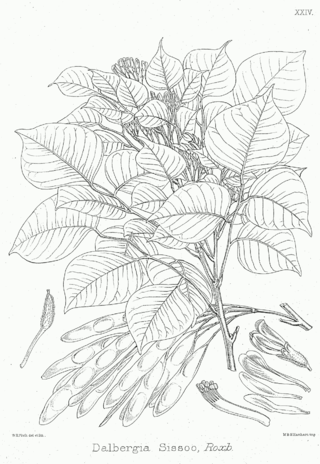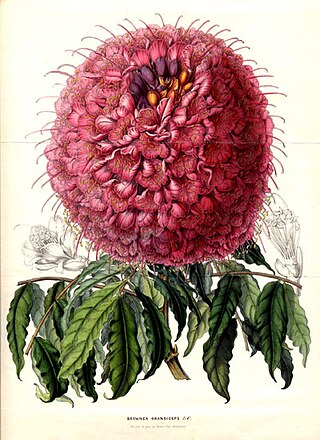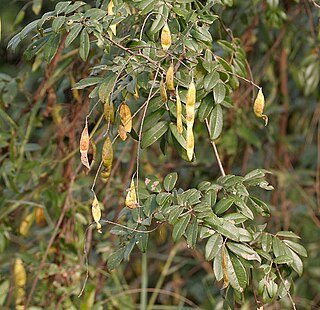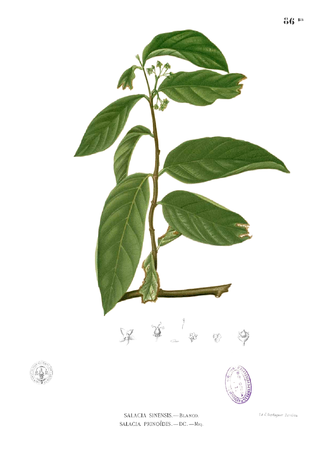Millettia is a large, broadly distributed genus of flowering plants in the legume family, Fabaceae. As of September 2023 [update] , there are 169 accepted species in Kew's Plants of the World Online. Species are found in tropical and subtropical areas throughout the Old World. [1]


- Millettia aboensis (Hook.) Baker
- Millettia achtenii De Wild.
- Millettia acuticarinata Baker f.
- Millettia ahernii Merr. & Rolfe
- Millettia angustidentata De Wild.
- Millettia angustistipellata De Wild.
- Millettia aromatica Dunn
- Millettia aurea (R.Vig.) Du Puy & Labat
- Millettia austroyunnanensis Y.Y.Qian
- Millettia barteri (Benth.) Dunn
- Millettia bequaertii De Wild.
- Millettia bipindensis Harms
- Millettia borneensis Adema
- Millettia brachycarpa Merr.
- Millettia brandisiana Kurz
- Millettia bussei Harms
- Millettia cabrae De Wild.
- Millettia caerulea Baker
- Millettia cana Benth.
- Millettia capuronii Du Puy & Labat
- Millettia caudata (Benth.) Baker
- Millettia chrysamaryssa Adema
- Millettia chrysophylla Dunn
- Millettia comosa (Micheli) Hauman
- Millettia conraui Harms
- Millettia coruscans Dunn
- Millettia cubittii Dunn
- Millettia densiflora Mattapha, Lanors. & Lamxay
- Millettia dinklagei Harms
- Millettia diptera Gagnep.
- Millettia discolor De Wild.
- Millettia drastica Welw. ex Baker
- Millettia dubia De Wild.
- Millettia duchesnei De Wild.
- Millettia dura Dunn
- Millettia ebenifera (Bertol.) J.E.Burrows & Lötter
- Millettia eetveldeana (Micheli) Hauman
- Millettia elongatistyla J.B.Gillett
- Millettia elskensii De Wild.
- Millettia entadoides Z.Wei
- Millettia eriocarpa Dunn
- Millettia erythrocalyx Gagnep.
- Millettia exauriculata Hauman
- Millettia extensa (Benth.) Benth. ex Baker
- Millettia ferruginea (Hochst.) Hochst. ex Baker
- Millettia fruticosa (DC.) Benth. ex Baker
- Millettia fulgens Dunn
- Millettia galliflagrans Whitmore
- Millettia geerinckiana O.Lachenaud
- Millettia glabra Adema
- Millettia glaucescens Kurz
- Millettia goossensii (Hauman) Polhill
- Millettia gracilis Welw. ex Baker
- Millettia grandis (E.Mey.) Skeels
- Millettia griffithii Dunn
- Millettia griffoniana Baill.
- Millettia harmandii Gagnep.
- Millettia harmsiana De Wild.
- Millettia hedraeantha Harms
- Millettia hitsika Du Puy & Labat
- Millettia hockii De Wild.
- Millettia hylobia Louis ex Hauman
- Millettia hypolampra Harms
- Millettia impressa Harms
- Millettia irvinei Hutch. & Dalziel
- Millettia kangensis Craib
- Millettia kennedyi Hoyle
- Millettia kerrii P.K.Lôc
- Millettia klainei Dunn
- Millettia lacus-alberti J.B.Gillett
- Millettia lane-poolei Dunn
- Millettia laotica Gagnep.
- Millettia lasiantha Dunn
- Millettia lastoursvillensis Pellegr.
- Millettia laurentii De Wild.
- Millettia lebrunii Hauman
- Millettia lecomtei Dunn
- Millettia lenneoides Vatke
- Millettia leonensis Hepper
- Millettia letestui Pellegr.
- Millettia liberica Jongkind
- Millettia limbutuensis De Wild.
- Millettia longipes Perkins
- Millettia lucens (Scott Elliot) Dunn
- Millettia lucida Gagnep.
- Millettia lundensis E.P.Sousa
- Millettia macrophylla Benth.
- Millettia macrostachya Collett & Hemsl.
- Millettia macroura Harms
- Millettia makondensis Harms
- Millettia mannii Baker
- Millettia melanocarpa (Hauman) Adomou
- Millettia merrillii Perkins
- Millettia micans Taub.
- Millettia mildbraedii Harms
- Millettia mossambicensis J.B.Gillett
- Millettia multiflora Collett & Hemsl.
- Millettia nathaliae Du Puy & Labat
- Millettia nepalensis R.Parker
- Millettia nigrescens Gagnep.
- Millettia nudiflora Welw. ex Baker
- Millettia nutans Welw. ex E.P.Sousa
- Millettia nyangensis Pellegr.
- Millettia oblata Dunn
- Millettia oraria (Hance) Dunn
- Millettia orientalis Du Puy & Labat
- Millettia oyemensis Pellegr.
- Millettia pachyloba Drake
- Millettia pallens Stapf
- Millettia paucijuga Harms
- Millettia peguensis Ali
- Millettia penduliformis Gagnep.
- Millettia penicillata Gagnep.
- Millettia phuwuaensis Mattapha & Suddee
- Millettia pilosa Hutch. & Dalziel
- Millettia platyphylla Merr. ex Dunn
- Millettia principis Gagnep.
- Millettia psilopetala Harms
- Millettia pterocarpa Dunn
- Millettia pubinervis Kurz
- Millettia puerarioides Prain
- Millettia puguensis J.B.Gillett
- Millettia pulchra (Voigt) Kurz
- Millettia rhodantha Baill.
- Millettia richardiana (Baill.) Du Puy & Labat
- Millettia rigens (Craib) Niyomdham
- Millettia ripicola E.P.Sousa
- Millettia rubiginosa Wight & Arn.
- Millettia sacleuxii Dunn
- Millettia sanagana Harms
- Millettia sapindifolia T.C.Chen
- Millettia sapinii De Wild.
- Millettia schliebenii Harms
- Millettia semseii J.B.Gillett
- Millettia sericantha Harms
- Millettia sericea (Vent.) Wight & Arn. ex Hassk.
- Millettia solomonensis Verdc.
- Millettia soyauxii Taub.
- Millettia splendens Wight & Arn.
- Millettia stenopetala Hauman
- Millettia stipellatissima Hauman
- Millettia stipulata Dunn
- Millettia stuhlmannii Taub.
- Millettia subpalmata Dunn
- Millettia suddeei Mattapha & Tetsana
- Millettia takou Lorougnon
- Millettia tanaensis J.B.Gillett
- Millettia taolanaroensis Du Puy & Labat
- Millettia tecta (Craib) Mattapha & Chantar.
- Millettia tenuipes Merr.
- Millettia tessmannii Harms
- Millettia tetraptera Kurz
- Millettia theuszii (Büttner) De Wild.
- Millettia thollonii Dunn
- Millettia thonneri De Wild.
- Millettia thonningii (Schumach. & Thonn.) Baker
- Millettia ulbrichiana Harms
- Millettia urophylloides De Wild.
- Millettia usaramensis Taub.
- Millettia vankerckhovenii De Wild.
- Millettia vatkei P.K.Lôc
- Millettia velutina Dunn
- Millettia velvetina Adema
- Millettia versicolor Welw. ex Baker
- Millettia viridiflora O.Lachenaud
- Millettia warneckei Harms
- Millettia wellensii De Wild.
- Millettia wieringae Adomou
- Millettia xylocarpa Miq.
- Millettia zechiana Harms













